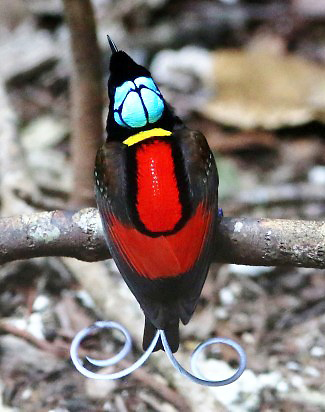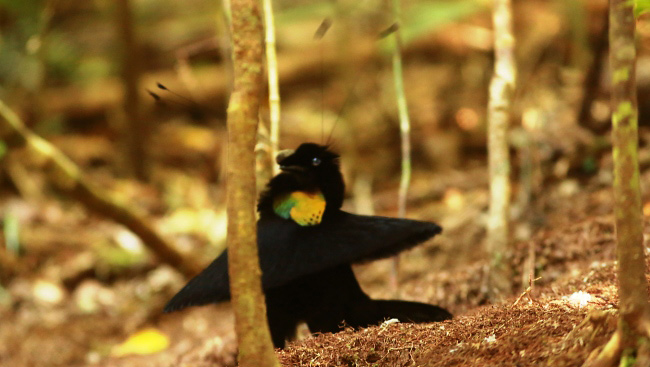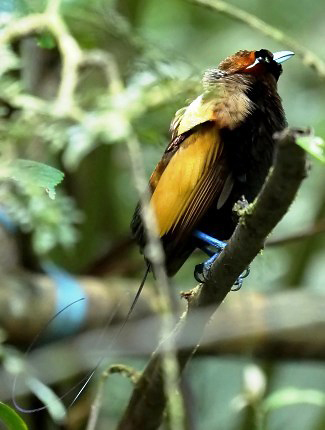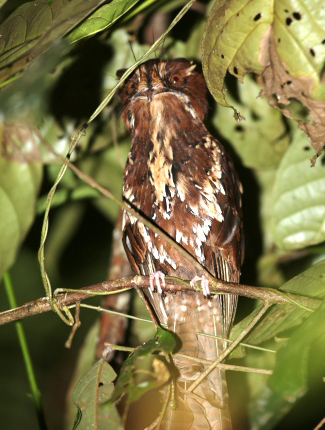

A fantastic male Wilson's Bird-of-paradise waiting for a female to come and inspect his display court on the island of Waigeo, an image captured by Nick Cobb from a palm-leaf hide a few metres away.
- Birds-of-paradise - the most amazing birds on planet Earth
- With a shocking blue 'skullcap' and frilled epaulettes (Wilson's), a 'tutu', side-to-side dance and waving head-wires (Western Parotia), a golden fan (Magnificent), shivering thick red and yellow plumes (Red and Lesser), candyfloss-yellow plumes and tail-wires (Twelve-wired), and extraordinary long head-pennants (King-of-Saxony)
- As well as astrapias, sicklebills, paradigallas and Red Satinbird
- Bowerbirds, including Masked Bowerbird, one of the brightest birds on Earth, with bowers and 'gardens' meticulously designed and tended by males
- Many of the island of New Guinea's other spectacular birds including crowned-pigeons, parrots, lorikeets, kingfishers and paradise-kingfishers, jewel-babblers, berryeaters and owlet-nightjars
- And three endemic monotypic bird families (those with just one species); Blue-capped Ifrit, Wattled Ploughbill and Mottled Berryhunter
- All along with Whale Sharks and over 1300 other fish species offshore, part of the greatest
concentration of marine life for an area of its size in the world
- The island of New Guinea, north of Australia, is arguably an island-continent, where evolution has gone mad with birds, notably the extraordinary architects, landscape gardeners and collectors known as bowerbirds, and especially the aptly-named birds-of-paradise, the males of which are the most amazing birds on Earth. They come in all shapes and sizes, from the tiny 'blood and snow' King Bird-of-paradise to the huge heron-sized dark and rather sinister Black Sicklebill, with everything imaginable in between. The birds may be fabulous but for the most part they are extremely elusive and birding in West Papua is as tough as it gets, so this is a destination where local guides are vital, not only to help with arranging boat trips and other transport, but to see the birds and to see them well. Most birds-of-paradise and bowerbirds for example are only likely to be seen well at their traditional display trees and courts, known to only a few. Unfortunately for those who prefer to travel independently this is virtually impossible in West Papua because the few local guides who can also provide transport are at full stretch during the short lowland dry season catering for the flood of organized tours. Prepare for rain, mud, heat, humidity, chiggers, mosquitoes, changes to the itinerary, basic camping, tough treks, shy birds and some sensational birds.
- There are many slight differences between West Papua and Papua New Guinea as far as birds are concerned but the main ones are that Wilson's Bird-of-paradise is endemic to West Papua, whereas Blue Bird-of-paradise and Ribbon-tailed Astrapia are endemic to Papua New Guinea, a parotia and Magnificent Bird-of-paradise are only likely to be seen dancing and displaying in West Papua, male Brown Sicklebill is only likely to be seen well in Papua New Guinea, and Macgregor's Honeyeater (a former bird-of-paradise) is usually on the beaten track in West Papua but a long way off it in Papua New Guinea.
- The account below does not cover the Merauke, Wayau and Wasur National Park area in the Trans-Fly region of the south, a low-lying region normally only fully accessible during the dry season, from July to November, and the latter part of this season is likely to be the best time because when there is little water left birds such as Southern Cassowary and Sclater’s Crowned-pigeon are (relatively!) more likely to be seen at the last remaining forest waterholes. Other species present include Black Bittern, Pied Heron, Papuan Eagle (especially around Waam), Palm Cockatoo, Spangled Kookaburra, Painted Quail-thrush, Greater Bird-of-paradise, and Black and Grey-crowned Munias.

A male Western Parotia displaying at its court in the Arfak Mountains of West Papua, an image captured by Nick Cobb. The bird's head and head-wires move so fast it's almost impossible to get them in focus!
- The numerous top wildlife destinations in the rest of Indonesia include Sulawesi and Halmahera where the many endemic birds include Maleo, Purple-bearded Bee-eater, Knobbed Hornbill, Ivory-breasted Pitta and Wallace's Standardwing; Komodo, home of the huge Komodo Dragon; Bali, where the very rare and very beautiful white Bali Myna is being reintroduced (not very successfully) to Bali Barat National Park which also supports Grey-rumped Myna, Great-billed Heron, Javan Plover and Javan Banded Pitta; Java, which is mostly a swarming mass of people but also supports the endemic Javan Gibbon, as well as Ebony and Grizzled Leaf Monkeys, and 40 endemic birds (57 with the adjacent island of Bali) including a trogon, a cochoa, a tesia and two sunbirds. However, there is virtually no chance of seeing one of the 50 or so Javan Rhinoceroses left in the world, all of which live in Ujung Kulon National Park; and Sumatra where Orang-utan, Siamang, White-handed Gibbon and endemic birds such as Graceful and Schneider's Pittas occur;
Best Birds and other wildlife in West Papua
Birds
Endemics 68 (Three paradise-kingfishers (on islands) and seven birds-of-paradise) Widespread 34 Red-billed Brush-turkey, Snow Mountain Quail, Western Crowned-pigeon, Western Ornate Fruit-dove, White-striped Forest-rail, Snow Mountain Tiger-parrot, Papuan Lorikeet (Vogelkop), Black Lory, Large Fig-parrot, Salvadori’s Fig-parrot, Blue-fronted (Orange-breasted) Fig-parrot, White-eared Catbird, Arfak (Black-eared) Catbird, Vogelkop Bowerbird, Brass’s Friarbird, Rufous-sided Honeyeater, Arfak Honeyeater, Orange-cheeked Honeyeater, Vogelkop Honeyeater, Vogelkop Scrubwren, Western Crested Berrypecker, Vogelkop Whistler, Baliem Whistler (northern slopes of Snow Mountains), Mamberamo (Little) Shrike-thrush, Western Parotia, Vogelkop Lophornia (Superb Bop), Long-tailed Paradigalla (Arfak Mountains), Arfak Astrapia (Arfak and Tamrau Mountains), Snow Mountain Robin (Oranje Mountains), Ashy Robin, Smoky Robin, Olive-crowned Flowerpecker, Grey-banded Mannikin/Munia (Arfak Mountains) and Black-breasted Mannikin/Munia.
Foja Mountains 3 Golden-fronted Bowerbird, Foja Honeyeater and Bronze Parotia.
West Papuan Islands 6 Waigeo (Bruijn’s) Brush-turkey (Waigeo), Spice Imperial-pigeon (widespread on mainly small islands. Also an old record from Widi Island off Halmahera), Waigeo (Raja Ampat) Pitohui (Waigeo, Gemien, Batanta and Sagewin), Waigeo (Little) Shrike-thrush (Waigeo), Wilson’s Bird-of-paradise (Waigeo and Batanta) and Red Bird-of-paradise (Waigeo and Batanta).
West Papuan Islands, north coast mainland and Aru Islands Brown-headed Crow.
Kofiau 2 Kofiau Paradise-kingfisher and Kofiau Monarch.
Geelvink (Bay) Islands 23 Biak, Numfor and other islands 7 Biak Scrubfowl, Geelvink Imperial-pigeon, Geelvink Fruit-dove, Black-winged Lory, Geelvink Pygmy-parrot, Geelvink Cicadabird and Long-tailed Starling.
Biak 14 Biak Coucal, Biak Scops-owl, Biak Paradise-kingfisher, Biak Lorikeet, Biak Hooded Pitta, Red-brown Myzomela, Biak Gerygone, Biak Whistler, Biak Triller, Biak Fantail, Biak Flycatcher, Biak Monarch, Biak Leaf-warbler and Biak White-eye. (Also, possibly, the endemic kordensis race of Golden Monarch)
Numfor 2 Numfor Paradise-kingfisher (Numfor only) and Numfor (Island) Leaf-warbler.
A bird first observed in 2014 in the Kumawa Mountains was seen again in 2017 and in 2021 Satin Berrypecker Melanocharis citreola was formally described. It is a sister species to the phenotypically dissimilar Streaked Berrypecker Melanocharis striativentris.
New Guinea Mainland, West Papuan and Geelvink (Bay) Islands, and Aru Islands Endemics 293 (Nine fruit-doves, seven owlet-nightjars, 13 kingfishers, nine bowerbirds, 48 honeyeaters, 35 birds-of-paradise and 21 robins) Northern Cassowary, Wattled Brush-turkey, Black-billed (Yellow-legged) Brush-turkey, Collared (Red-legged) Brush-turkey, New Guinea Scrubfowl, Salvadori’s Teal, New Guinea Bronzewing, Cinnamon Ground-dove, Western Bronze Ground-dove, Thick-billed Ground-pigeon, Green-naped Pheasant-pigeon, Sclater’s Crowned-pigeon, Victoria Crowned-pigeon, Purple-tailed Imperial-pigeon, Shining (Rufescent) Imperial-pigeon, Pinon’s Imperial-pigeon, Collared Imperial-pigeon, Zoe’s Imperial-pigeon, Dwarf Fruit-dove, Orange-fronted Fruit-dove, Eastern Ornate Fruit-dove, Pink-spotted Fruit-dove, Orange-bellied Fruit-dove, Beautiful Fruit-dove, Coroneted Fruit-dove, Archbold’s Nightjar, Papuan Nightjar, Feline Owlet-nightjar, Spangled (Starry) Owlet-nightjar (small range), Allied (Vogelkop) Owlet-nightjar, Barred Owlet-nightjar, Wallace’s Owlet-nightjar, Archbold’s Owlet-nightjar, Mountain Owlet-nightjar, Papuan Spinetail, Papuan (Three-toed) Swiftlet, Bare-legged Swiftlet, Mountain Swiftlet, Ivory-billed (Greater Black) Coucal, Black-billed (Lesser Black) Coucal, Dwarf Koel, Long-billed Cuckoo, Rufous-throated Bronze-cuckoo, White-eared Bronze-cuckoo, White-crowned Cuckoo (Koel), Chestnut Forest-rail, Forbes’s Forest-rail, Mayr’s Forest-rail, New Guinea Flightless Rail, Forest Bittern, New Guinea Woodcock, Jungle (Papuan) Boobook, Papuan Hawk-owl, Long-tailed Honey-buzzard, Papuan (New Guinea) Eagle, Papuan Harrier (mostly Papua New Guinea), Grey-headed Goshawk, Black-mantled Goshawk, Chestnut-shouldered Goshawk, Doria’s Goshawk, New Guinea (Papuan) Dwarf-kingfisher, Mountain Kingfisher, Blue-black Kingfisher, Little Paradise-kingfisher, Red-breasted Paradise-kingfisher, Hook-billed Kingfisher, Spangled Kookaburra, Rufous-bellied Kookaburra, Shovel-billed Kingfisher, Pesquet’s Parrot, Brehm’s Tiger-parrot, Painted Tiger-parrot (mostly Papua New Guinea), Modest Tiger-parrot, Madarasz’s Tiger-parrot, Plum-faced Lorikeet, Striated Lorikeet, Pygmy Lorikeet, Red-fronted Lorikeet, Fairy Lorikeet, Josephine’s Lorikeet, Stella’s (Papuan) Lorikeet, Yellow-billed Lorikeet, Orange-billed Lorikeet, Black-capped Lory, Brown Lory, Yellow-streaked Lory, Dusky Lory, Goldie’s Lorikeet, Yellow-naped (Large) Fig-parrot, Red-faced (Large) Fig-parrot (mostly Papua New Guinea), Edwards’s Fig-parrot (mostly Papua New Guinea), Black-fronted (Orange-breasted) Fig-parrot, Dusky-cheeked (Orange-breasted) Fig-parrot, Orange-fronted (Papuan) Hanging-parrot, Papuan King-parrot, Blue-collared Parrot, Eastern Hooded Pitta, Ochre-breasted (White-eared) Catbird, Tan-capped (White-eared) Catbird, Northern Catbird, Archbold’s Bowerbird, MacGregor’s Bowerbird, Flame Bowerbird, Masked Bowerbird, Yellow-breasted Bowerbird, Papuan Treecreeper, Wallace’s Fairy-wren, Orange-crowned Fairy-wren, Broad-billed Fairy-wren, Emperor Fairy-wren, White-shouldered Fairy-wren, Silver-eared Honeyeater, Spotted Honeyeater, Meyer’s Friarbird, New Guinea (Helmeted) Friarbird, Ruby-throated Myzomela, Papuan Black Myzomela, Mountain (Elfin) Myzomela, Red-collared Myzomela, Plain Honeyeater, Marbled Honeyeater, Streak-headed Honeyeater, Leaden Honeyeater, Yellowish-streaked Honeyeater, Mayr’s Honeyeater, Grey-streaked Honeyeater, Long-billed Honeyeater, Tawny Straightbill, Olive Straightbill, MacGregor’s Honeyeater, Smoky Honeyeater, Puff-backed Honeyeater, Scrub Honeyeater, Hill-forest Honeyeater (Meliphaga), Mimic Honeyeater, Forest Honeyeater, Mottle-breasted Honeyeater (Spot-breasted Meliphaga), Graceful Honeyeater, Yellow-gaped Honeyeater, Obscure Honeyeater, Black-throated Honeyeater, Sooty Honeyeater (Meliphaga), Short-bearded Honeyeater (Meliphaga) (mostly West Papua), Cinnamon-browed Honeyeater (Meliphaga), Belford’s Honeyeater (Meliphaga), Yellow-browed Honeyeater (Meliphaga) (mostly Papua New Guinea), Ornate Honeyeater (Meliphaga), Goldenface, Yellow-bellied Gerygone, Brown-breasted Gerygone, Rusty Mouse-warbler, Bicoloured Mouse-warbler, Mountain Mouse-warbler, Pale-billed Scrubwren, Papuan Scrubwren, Buff-faced Scrubwren, Grey-green Scrubwren, Perplexing Scrubwren, Large Scrubwren, Grey Thornbill, New Guinea (Papuan) Thornbill, Papuan Logrunner, Papuan Babbler, Wattled Ploughbill, Papuan Sittella, Black Sittella, Northern Variable Pitohui, Southern Variable Pitohui, Hooded Pitohui, Brown Oriole, Tit Berrypecker, Eastern Crested Berrypecker, Rufous-naped Bellbird, Piping Bellbird, Spotted Jewel-babbler, Chestnut-backed Jewel-babbler, Blue Jewel-babbler, Painted Quail-thrush, Black Pitohui, Regent Whistler, Sclater’s Whistler, Lorentz’s Whistler, Rusty Whistler, Black-headed Whistler, Golden-backed Whistler, Rusty Pitohui, White-bellied Pitohui, Sooty Shrike-thrush, Sepik-Ramu (Little) Shrike-thrush, Papuan Whipbird, Hooded Cuckooshrike, Boyer’s Cuckooshrike, Golden Cuckooshrike, Black-bellied Cuckooshrike, Grey-headed Cicadabird, Black-shouldered (Papuan) Cicadabird, New Guinea (Black) Cicadabird, Black-browed Triller, Mottled Berryhunter, Lowland Peltops, Mountain Peltops, Hooded Butcherbird, Great Woodswallow, Black-breasted Boatbill, Drongo Fantail, Black Fantail, Sooty Thicket-fantail, Black Thicket-fantail, White-bellied Thicket-fantail, Dimorphic Fantail, Rufous-backed Fantail, Friendly Fantail, Chestnut-bellied Fantail, Blue-capped Ifrit(a), Ochre-collared Monarch, Frilled Monarch, Torrent-lark, Black (Fan-tailed) Monarch, Rufous Monarch, Spot-winged Monarch, Hooded Monarch, Golden Monarch, Grey Crow, Lesser Melampitta, Greater Melampitta, Glossy-mantled Manucode, Jobi Manucode, Crinkle-collared Manucode, King-of-Saxony Bird-of-paradise, Carola’s Parotia, Twelve-wired Bird-of-paradise, Black-billed Sicklebill, Pale-billed Sicklebill, Broad-plumed (Greater) Lophornia, Black Sicklebill, Brown Sicklebill, Short-tailed Paradigalla, Splendid Astrapia, King Bird-of-paradise, Magnificent Bird-of-paradise, Lesser Bird-of-paradise, Greater Bird-of-paradise, Obscure Berrypecker, Black Berrypecker, Mid-mountain Berrypecker, Fan-tailed Berrypecker, Streaked Berrypecker, Thick-billed (Spotted) Berrypecker, Spectacled Longbill, Pygmy Longbill, Yellow-bellied Longbill, Slaty-headed (Slaty-chinned) Longbill, Loria’s Satinbird, Red (Crested) Satinbird, Yellow-breasted Satinbird, Greater Ground-robin, Lesser Ground-robin, Green-backed Robin, White-eyed Robin, Garnet Robin, Subalpine Robin, Olive Flyrobin, Canary Flyrobin, Torrent Flyrobin, Papuan Scrub-robin, Black-throated Robin, Black-chinned Robin, Black-sided Robin, Black-capped Robin, Banded Yellow (Olive-yellow) Robin, White-winged Robin, Blue-grey Robin, White-rumped Robin, Papuan Grassbird, Fly River Grassbird, Black-fronted White-eye, Green-fronted White-eye, Capped White-eye, New Guinea White-eye, Yellow-faced Myna, Golden Myna, Yellow-eyed Starling, Red-capped Flowerpecker, Rand’s (Olive-backed) Sunbird, Streak-headed Mannikin, White-spotted (Streak-headed) Mannikin, Great-billed (Grand) Munia, Grey-crowned Munia, Black Munia, Snow Mountain Munia, Mountain Firetail, Papuan Parrotfinch and Alpine Pipit.
Other Near-endemics
West Papuan Islands and Moluccas 4 Dusky Scrubfowl, Violet-necked Lory, Moluccan King-parrot and Island Whistler.
West Papuan Islands to Sulawesi 1 Sultan’s Cuckoo-dove.
Kofiau (West Papua) and Moluccas 1 Spectacled (Moluccan) Imperial-pigeon.
Misool (West Papua) to Moluccas 1 Moluccan Scrubfowl.
New Guinea and Moluccas 3 Gurney’s Eagle, Pygmy Eagle and Common Paradise-kingfisher.
New Guinea, Kai Islands and Gebe 1 Yellow-capped Pygmy-parrot.
New Guinea and New Britain (Bismarck Archipelago) 3 Dwarf Cassowary, Red Myzomela and Hooded Mannikin (Munia).
New Guinea and Bismarck Archipelago 3 Black-billed Cuckoo-dove, Purple-bellied Lory (Papua New Guinea only) and Buff-faced Pygmy-parrot.
New Guinea to Solomon Islands 5 White-breasted (White-bibbed) Ground-dove, Island Imperial-pigeon (islands off New Guinea), Papuan Eclectus, Melanesian Cicadabird (Papua New Guinea only) and Singing Starling.
New Guinea, Solomon Islands and Australia 1 Russet-tailed Thrush (Papua New Guinea only, and Choiseul Island in the Solomon Islands).
New Guinea and Australia 92 Magpie Goose, Marbled Frogmouth, Papuan Frogmouth, White-throated Nightjar (Papua New Guinea only), Australian Owlet-nightjar (Papua New Guinea only), Black-eared Cuckoo (rare in Indonesia), Pallid Cuckoo (rare in Indonesia), Brolga (Crane), Australian Bustard, Straw-necked Ibis, White-necked (Pacific) Heron, Bush Thick-knee, Pied Oystercatcher (also recorded on Kai Islands), Masked Lapwing (irregular in Indonesia), Red-kneed Dotterel, Australian Gull-billed Tern, Greater Sooty-owl, Australian Masked-owl, Rufous Owl, Wedge-tailed Eagle, Collared Sparrowhawk, Whistling Kite, Yellow-billed Kingfisher, Forest Kingfisher (rare in Indonesia), Torresian (Collared) Kingfisher, Buff-breasted Paradise-kingfisher, Blue-winged Kookaburra, Nankeen (Australian) Kestrel (also Christmas Island, and rare in Indonesia), Brown Falcon, Palm Cockatoo (Cape York only in Australia), Little Corella, Sulphur-crested Cockatoo, Double-eyed Fig-parrot, Red-winged Parrot, Papuan Pitta, Noisy Pitta, Black-eared Catbird (Cape York only in Australia), Fawn-breasted Bowerbird (Cape York only in Australia), Brown Honeyeater, Blue-faced Honeyeater, White-throated Honeyeater, Tawny-breasted Honeyeater (Cape York only in Australia), Little Friarbird, Noisy Friarbird, Dusky Myzomela, Red-headed Myzomela, Green-backed Honeyeater (Cape York only in Australia), Brown-backed Honeyeater, Rufous-banded Honeyeater, Varied Honeyeater, Yellow-tinted Honeyeater, Fairy Gerygone, Green-backed Gerygone, White-throated Gerygone (Papua New Guinea only), Large-billed Gerygone, Mangrove Gerygone (Papua New Guinea only), Tropical Scrubwren (Cape York only in Australia), Grey-crowned Babbler, Australasian Figbird, Olive-backed Oriole, Green Oriole (also Romang Island, east of Timor), Brown (Grey) Whistler, Black-tailed Whistler, Little Shrike-thrush, Rufous (Little) Shrike-thrush, Grey Shrike-thrush, White-winged Triller (Papua New Guinea only), Varied Triller, Black Butcherbird, Australian Magpie, Black-backed Butcherbird (Cape York only in Australia), Black-faced Woodswallow (range also reaches Timor, Leti and Sermata), Yellow-breasted Boatbill, Northern Fantail, Mangrove Fantail (Papua New Guinea and Aru Islands only), Leaden Flycatcher, Satin Flycatcher, Paperbark Flycatcher, Magpie-lark (also east Timor), Black-winged Monarch (Cape York only in Australia), Black-faced Monarch, Trumpet Manucode (Cape York only in Australia), Magnificent Riflebird (Cape York only in Australia), Yellow-legged Flyrobin (Cape York only in Australia), Lemon-bellied Flyrobin, Jacky Winter (Papua New Guinea only), White-faced Robin (Cape York only in Australia), Mangrove Robin, Little Grassbird (West Papua only), Chestnut-breasted Munia, White-bellied Crimson Finch (Cape York only in Australia) and Australasian Pipit (Papua New Guinea only).
Others
Lesser Frigatebird, Great-billed Heron, Brahminy Kite, White-bellied Sea-eagle, Papuan Eclectus, Channel-billed Cuckoo, Moustached Treeswift, Beach
Kingfisher, Rainbow Bee-eater, Oriental Dollarbird, Papuan (Blyth's) Hornbill and Island Thrush.
Mammals
A chance of Great Spotted and Waigeo Cuscuses, and Striped Possum.
Reptiles, Amphibians and Fish
The islands of the Raja Ampat Archipelago off West Papua,
including Batanta, Salawati and Waigeo, lie in an area with the greatest concentration of marine life for an area of
its size in the world, with over 1300 fish species, twice as many as there are in the Red Sea and the Caribbean.
Whale Sharks are present year round in Cenderawasih Bay between Manokwari and Biak, where it is possible to dive and
swim with them.
Best Sites for Birds and other wildlife in West Papua
- Sorong area Black Lory and Red-breasted Paradise-kingfisher.
- Raja Ampat Archipelago islands of Batanta, Salawati and Waigeo Red and Wilson's Birds-of-paradise (display sites for both on Batanta and Waigeo), and Western Crowned-pigeon, as well as Lesser Frigatebird, Great-billed Heron, Palm Cockatoo and Beach Kingfisher. Also a chance of Red-billed Brush-turkey, Gurney's Eagle, Green-naped Pheasant-pigeon, Moluccan King-parrot, Hook-billed Kingfisher and White-eared Catbird.
- Arfak Mountains Western Parotia (display courts with screens), Black Sicklebill, King and Magnificent (display courts with screens) Birds-of-paradise, Vogelkop Lophornia, Lesser Melampitta, and Masked (foothills) and Vogelkop (bowers with screens) Bowerbirds, as well as White-striped Forest-rail, Feline and Mountain Owlet-Nightjars, Arfak (Western Smoky) and Rufous-sided Honeyeaters, Cinnamon-browed Honeyeater, Vogelkop Scrubwren, Vogelkop Whistler, Mottled Berryhunter, Drongo Fantail and Smoky Robin. Also a chance of Arfak Astrapia and Long-tailed Paradigalla, as well as Wattled Brush-turkey, Papuan Eagle, Chestnut-backed and Spotted Jewel-babblers, Papuan Logrunner and Arfak Catbird.
- Lake Sentani Fawn-breasted Bowerbird, and Great-billed and Hooded Munias.
- Jalan Korea/Nimbokrang/Northern Lowlands Pale-billed Sicklebill, King, Lesser and Twelve-wired Birds-of-paradise (display
sites for all three) and Jobi Manucode, as well as Palm Cockatoo, Salvadori's Fig-parrot, Victoria Crowned-pigeon and Blue-black Kingfisher. Also a
chance of Northern Cassowary, Pesquet's Parrot, Shovel-billed Kingfisher, Blue
Jewel-babbler and White-eared Catbird. - Grand Baliem - Ibele Valley - Lake Habbema (at 3300 m (10,000 ft)) Splendid Astrapia, King-of-Saxony Bird-of-paradise, Broad-plumed Lophornia, Brown Sicklebill, Short-tailed Paradigalla, Lesser Melampitta, Loria's and Red Satinbirds, Macgregor's Honeyeater and Archbold's Bowerbird, as well as Salvadori's Teal, Snow Mountain Quail, New Guinea Woodcock, Wattled Ploughbill, Blue-capped Ifrit, Western Crested Berrypecker, Torrent-lark and, near the summit of Mount Trikora at 4300 m (14,000 ft), Snow Mountain Robin.

A male Magnificent Bird-of-paradise above its court in the Arfaks, by Paul Macklam.

A roosting Feline Owlet-Nightjar in the Arfaks, by Nick Cobb.
Best Times for Birds and other wildlife in West Papua
West Papua has a warm, wet equatorial climate and rain falls year round in the highlands, but there is usually a dry season in the lowlands which lasts from May to October and this is the best time to go, especially September-October for displaying birds of paradise. The best scuba-diving and snorkeling conditions overlap with both ends of this season, from April to June and September to November.
Recommended Bird Books etc. for West Papua
Birds of New Guinea by P Gregory. Lynx Edicions, 2017.
Birds of New Guinea by T K Pratt and B M Beehler. PUP, 2014 (Second Edition).
Birds of New Guinea by B M Beehler et al. PUP, 1986 (First Edition but arguably better than the Second).
Birds of New Guinea and the Bismarck Archipelago: Photographic Guide by B Coates. Dove Publications, 2001.
Birds of Paradise and Bowerbirds (Helm Identification Guide) by P Gregory and R Allen. Helm, 2020.
Birding Indonesia edited by P Jepson and R Ounsted. Periplus Editions, 1997.
Mammals of New Guinea by T Flannery. Cornell University Press, 1995 (Revised Edition).
Where to watch birds in Australasia & Oceania by N Wheatley. Helm, 1998.
Don’t know which country/countries/regions to visit in Australasia? Then it may be worth considering taking a look at this book, written by this website’s author. It is many years old of course but it still provides a starting point, an overview and a guiding light to the best birds and the best places to look for them in the region, and could save hours of searching for similar information on the internet. However, it is important to check more up-to-date sources for sites which have been opened up, sites and species which have been discovered, lodges that have been built etc. since the book was published.
Birding and Wildlife Trip Reports for West Papua
Many trip reports, some for West Papua, are posted on the websites listed here. On some of these websites some reports are independent and some are posted by tour companies who organize tours to West Papua. These tour companies and others also post their own reports on their websites, which are listed under 'Some Organized Tours to West Papua' below.
- The best website for trip reports is CloudBirders
- but these are also worth a look
- Birdtours
- Fatbirder
- Jon Hornbuckle
- Mammal Watching
Local bird and wildlife guides in West Papua
The costs of organized tours partly reflect the quality of the tour leaders. Some leaders are certainly better than others and many companies claim their leaders are the best but even the best rely at least to some extent on the exceptional skills of the local guides they employ. If you are travelling independently, employing such local guides will greatly increase your chances of seeing the wildlife you wish to see.
Accommodation for birders in West Papua
Some Organized Tours for birds and other wildlife to West Papua
There are many tour companies who organize tours to see mammals, birds, other wildlife and other natural wonders. The cost of these tours vary considerably according to such variables as the airlines used, the number of days the tours last, the number of sites visited, the number of people in the group (an important consideration if you wish to see such wildlife as rainforest mammals and birds), the number of tour leaders, the standard of accommodation and transport, and the percentage profit the company hopes to make. Generally, where the number of days tours last and the number of sites visited are similar, the cheapest tours are those that use the cheapest airlines, accommodation and local transport, that have the largest groups with the least number of leaders, and that make the least amount of profit. The most expensive tours tend to be those which are exceptionally long, use the most expensive accommodation (ridiculously lavish in some cases, even for single nights) and which make the most profit. Some tour costs partly reflect the quality of the tour leaders. Some leaders are certainly better than others and many companies claim their leaders are the best but even the best rely at least to some extent on the exceptional skills of the local guides they employ.
While tour companies organize tours with set itineraries many also organize custom tours for individuals and private groups who instead of taking a tour with a set itinerary want to follow their own itinerary to suit their own personal tastes, whether it be mammals, birds, other wildlife, other natural wonders or even man-made attractions, or a mixture of them all. Many organized tours with set itineraries are also fast-paced and target as many species as possible, whether they are mammals, birds or other wildlife or everything, which usually leaves little time to enjoy the best sites and individual species, but on a custom tour those taking part can specify the pace and the sites and species they wish to concentrate on. Custom tours also suit people who like to travel with people they already know, rather than with a group of strangers, and people with partners with different interests. Individuals and small groups will almost certainly have to pay more than the price of an organized tour with a set itinerary but a large group of friends may be able to travel for less than the price quoted for a set tour.
Tour companies who run organized tours or can arrange custom tours to West Papua include the following.
- Bird Malaysia
- by Birders, for Birders and the Birds
- “With over 25 years experience, Bird Malaysia offers the best spots and time for birds and the best accommodation for our fellow birdies. Our tours are designed to ensure a comfortable and successful birdwatching experience. We look forward to welcoming and guiding you!”
- Irshad Mobarak – Birder & founder.
- Birdquest
- Birdtour Asia
- Sultan Birding Tours
- Sultan Birding Tours Indonesia, specialized in operating bird photography and bird watching for Birds of Paradise in West Papua, covering an area of Jayapura/Nimbokrang, Biak/Numfor, Wamena, Mount Arfak, Sorong, Malagufuk, Waigeo, and Raja Ampat islands.
